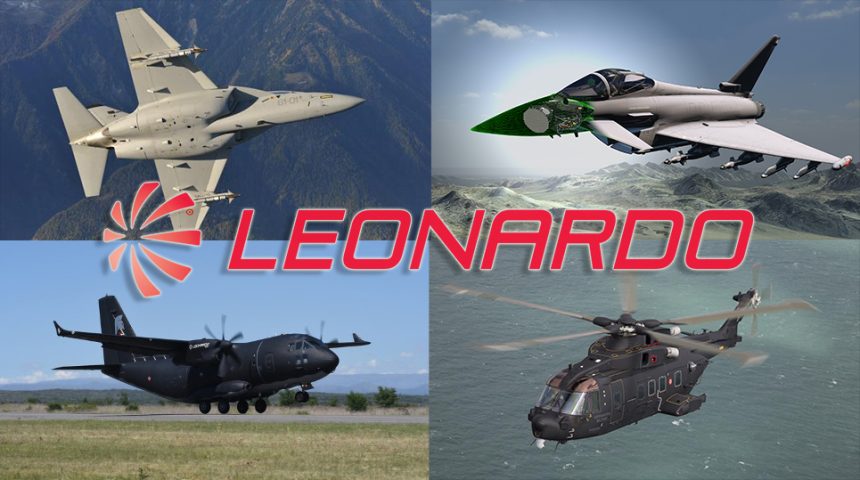Leonardo is one of the world’s top ten players in Aerospace, Defense and Security. Let’s have a look at the status of its most important projects in the Aeronautics, Helicopters, Space and Electronics businesses.
Named after the Italian inventor Leonardo da Vinci (although some people know or still refer to it by its previous names, Finmeccanica, or Leonardo-Finmeccanica – the transitional name adopted as part of the restructuring process launched in 2016), Leonardo is a global company headquartered in Italy specialising in aerospace, defence and security.
With 49,000 employees and a yearly revenue of 13.8B Euro (in 2019), it is ranked 8th among the world’s largest defense contractors. The company operates across the globe, with an industrial presence in four domestic markets (Italy, UK, Poland and the U.S.) backed by an international commercial network in about 40 countries worldwide as well as a number of subsidiaries, strategic partnerships, and joint ventures.
Many types of military and commercial aircraft, helicopters, sensors and systems are designed, developed, manufactured or assembled by Leonardo and in use in about 150 countries: C-27J, M-346, AW.101, AW.109, AW.139, AW.169, ATR-42 and ATR-72, are just the names of the very well known ones. Among all the other things, Leonardo owns the 21% of Eurofighter GmbH (the multinational company that co-ordinates the design, production and upgrade of the Typhoon) and leads the Euroradar consortium responsible for developing the Captor-E radar. The company is also an industrial partner in the F-35 program with the responsibility for assembling all aircraft for the Italian and Dutch armed forces and the second source supplier for the whole wing sections (the central part of the fuselage with the wings) for all F-35 in production.
Being based in Italy, we have always kept a close eye on the main projects and activities of Leonardo and for this reason, today, The Aviationist is able to offer you a unique status update on the company’s most interesting programs and news in the fields of Aeronautics, Helicopters, Space and Electronics.
AERONAUTICS
Made so particular by the COVID-19 pandemics, 2020 has seen Leonardo pretty active in the Aeronautics business. As we have already reported in response to dramatic emergencies of the year, the C-27J Spartan began in January to support the population in Australia, hit by tremendous bushfires, flying in extreme conditions for the evacuation of populations and wildlife. Conceived as a robust, reliable and performing military tactical transport aircraft, suitable for the support and supply of troops on the battlefield in the most hostile operational scenarios, the C-27J Spartan revealed itself as an extremely versatile and effective aircraft as response to the health emergency, employed intensively by most its Air Forces operators to carry out delivery of materials and health equipment, urgent transport of personnel, up to the most complex medical transports also in bio-containment mode. Interestingly, some operators further extended the spectrum of missions the platform is able to carry out by adding the capability to airdrop air-sea rescue kits or fuel containers needed to install FARPs (Forward Arming and Refueling Points) in austere locations.
By the way, during the year we also got a glimpse at a pretty rare, special mission C-27J operated by the Italian Air Force in the EW (Electronic Warfare) role: the EC-27J JEDI.
A remarkable news came in November, when Leonardo announced that the C-27J Spartan Next Generation entered the final testing phase and was being prepared for delivery to an undisclosed customer in 2021. The improved aircraft features new equipment, avionics and aerodynamic devices, most notably new winglets, that are intended to boost even more the performance and reliability of the Spartan.
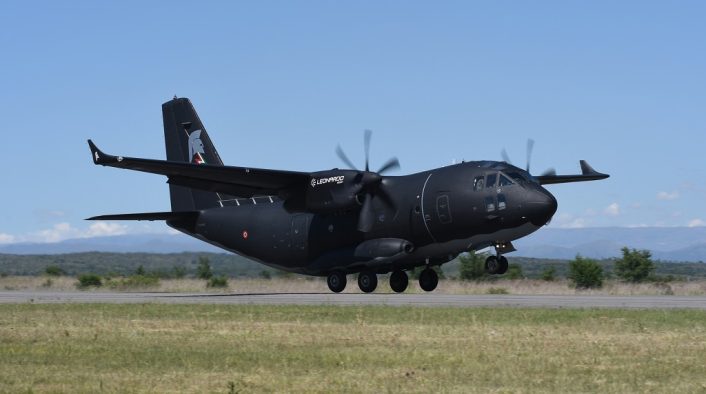
Another important update came from the trainers line of business.
After achieving the certification by the DAAA (Directorate for Air Armaments and Airworthiness), the certification Authority of the Italian Ministry of Defence, in May, the first two Leonardo’s new M-345 basic/advanced trainers were delivered to Italian Air Force in Decemeber. The Italian Air Force has ordered 18 M-345 aircraft, with plans to field up to 45 new aircraft, to replace the ageing MB-339 used for training and for the Frecce Tricolori display team.
The M-345 is the one of the major news on the market in this 2020: a new generation jet at the edge of its class in terms of performance, providing jet performance at turboprop costs. What makes the aircraft particularly interesting is also the training effectiveness coming from the experience the company and its customers have grown with the M-346 Master. As for its “big brother”, the M-345 is also part of a fully developed new generation training system that includes Embedded Tactical Training Simulation (ETTS) on board and a ground based training System up to Live Virtual Constructive (LVC) capability, that integrates the aircraft in-flight, simulators on ground and synthetic/virtual “friends” or “enemies” elements. LVC allows exposing the future pilot to the most complex operational scenarios at the lowest costs, and is today the element that draws a separating line between the future and the current generation training systems.
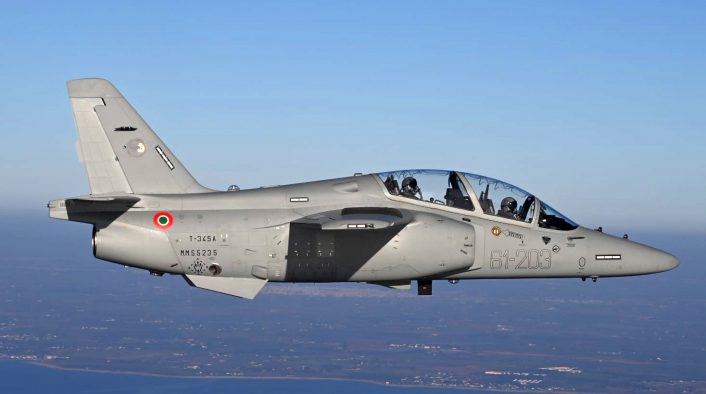
Jul. 13, 2020 is the day that marked the successful maiden flight for the M-346FA (Fighter Attack). Developed to meet the growing and diversified operational requirements of several air forces, the M-346FA keeps all the characteristics of the advanced trainer version, but it is also a light fighter aircraft able to carry out a wide range of operational missions at far lower costs than those of front-line fighters: from Air-to-Air [Air policing/homeland defence; Slow mover intercept (SMI)], to Air-to-Ground [Close Air Support (CAS); Counter Insurgency (COIN); Forward Air Controller – Airborne (FAC-A); Combat Search And Rescue (CSAR); Interdiction; Battlefield Air Interdiction (BAI); Tactical Air Support for Maritime Operations (TASMO)].
The aircraft is equipped with a Leonardo Electronics Division mechanically scanned multi-mode Grifo-M346 radar, specifically optimized for this aircraft, with Identification Friend or Foe (IFF), and protected by a complete self-protection system (DASS – Defensive Aids Sub-System), the M-346 benefits of a reduced radar cross-section and, according to Leonardo, can also have an additional “low observation” capability kit. M-346 FA will be handed over in 2021 to its first international customer.
The delivery in October of the final and most advanced Eurofighter Typhoon for the Italian Air Force, which completes the Eurofighter fleet as the main asset of a complex and diversified national and NATO air defence system, is a major programme milestone, closing a first chapter while the next one for the Eurocanard program was just kicking off: the “Quadriga” program in Germany. As part of the program, the German Air Force will replace older Eurofighters of Tranche 1, with so-called Tranche 4 aircraft. The new batch is expected to be divided in 31 single-seat and 7 two-seats aircraft. The new configuration will include the latest Phase 3 Enhancements (P3E) and the E-SCAN AESA radar, also known as European Common Radar System (ECRS). The German aircraft will be equipped with the ECRS Mk 1 variant, an improved version of the Mk 0 that is being produced for the Typhoons bought by Kuwait and Qatar. The same radar will be also retrofitted on the other 110 Eurofighter in the Luftwaffe’s inventory, of which 79 are from Tranche 2 and 31 from Tranche 3.
Through the Long Term Evolution plan, the partners will be able to will keep Eurofighter Typhoon at the leading edge of swing-role combat aircraft technology.
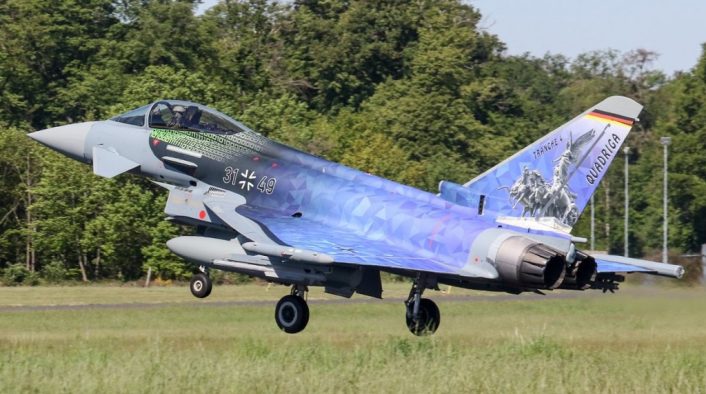
Last but not least, while the commercial aviation faces one of the most adverse periods of its history, on Dec. 15, 2020, the delivery of the first Purpose-Built Regional ATR Freighter, the first new ATR72-600F delivered to FedEx marks the arrival on the market of a versatile, technology advanced, fuel efficient aircraft, that according to the company “well fits in the changing of the market and the growth of e-commerce, to connect communities and economies around the world.”
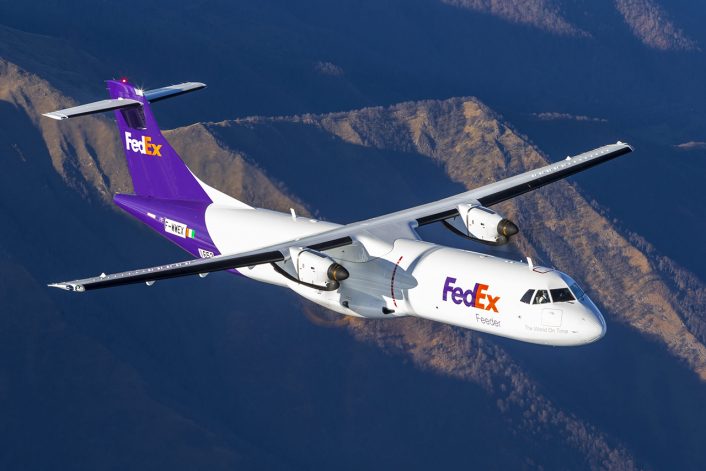
The last achievement of the year is represented by the groundbreaking ceremony for the new International Flight Training School (IFTS), celebrated on Dec. 16, at Decimomannu Air Base, Sardinia, Italy. IFTS is the result of a strategic collaboration between the Italian Air Force and Leonardo, which is aimed at the establishment of an advanced flight-training centre.
This initiative is set to become an international benchmark for military pilots’ training, particularly in the advanced phase of training future fighter pilots: with the new Leonardo M-345, the Italian Air Force’s 61° Stormo (Wing) will gradually replace the T-339A and FT-339C (MB-339A and MB-339CD) fleets at Lecce Galatina AB, and the M-346-based advanced phase of the training syllabus will be progressively moved to the “Deci”.
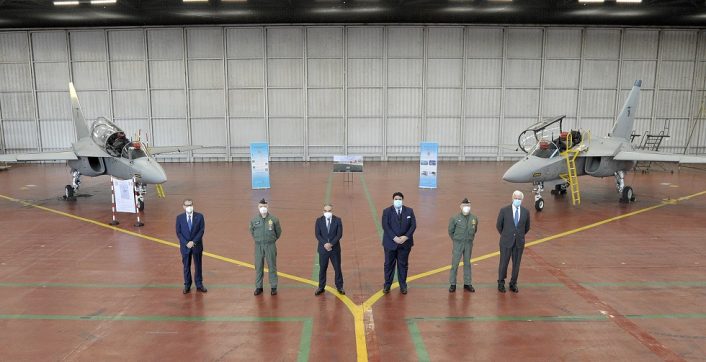
HELICOPTERS
In 2020 Leonardo reported several important achievements in the military market and strengthened its global position growing its industrial capabilities as well as product and service perimeter.
Ahead of the pandemic, the Company was awarded by the US Department of Defence (DoD) a 176M USD contract for the supply of 32 TH-73A helicopters (based on the TH-119 IFR single engine) to meet the Navy Trainer requirement to train the next generators of naval aviators. Later in the year the DoD exercised options for an additional 36 units, valued at 171M USD. The programme, which has a total requirement for up to 130 units, marks the first time Leonardo is prime contractor for the US DoD in the rotorcraft domain and came less than a year and a half following the selection of the Boeing MH-139A Grey Wolf – based on the world-class AW139 – by the US DoD for the USAF.
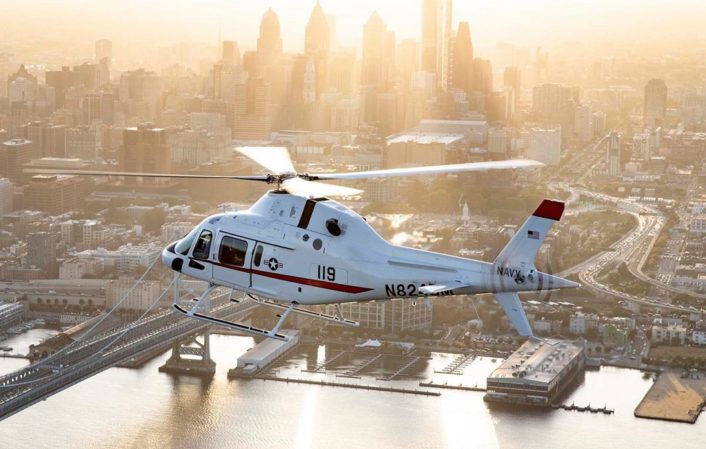
At the beginning of the year Leonardo also announced the acquisition of Swiss manufacturer Kopter and its next generation SH-09 single engine helicopter. With the company integration ongoing, according to the company, Leonardo aims at introducing into the market a high performance, state-of-the-art product allowing to further expand its civil certified aircraft product range and presence in a highly competitive market segment. Also, the acquisition of Kopter allows for future technological development making of this Swiss legal entity a centre of competence for new light helicopters as well as to design disruptive propulsion such as hybrid and electrical.
Although COVID-19 had a heavy impact on the global helicopter market as a whole, Leonardo was able to pursue further programme opportunities, particularly in the home military markets, with the IMOS (Integrated Merlin Operational Support) programme for the UK MoD’s Merlin fleet, the launch of Italian Army’s LUH (Light Utility Helicopter) programme based on the AW169M and continuing in the development of the AW249 as the New Exploration and Escort helicopter designed to replace the Italian Army’s AW129s.
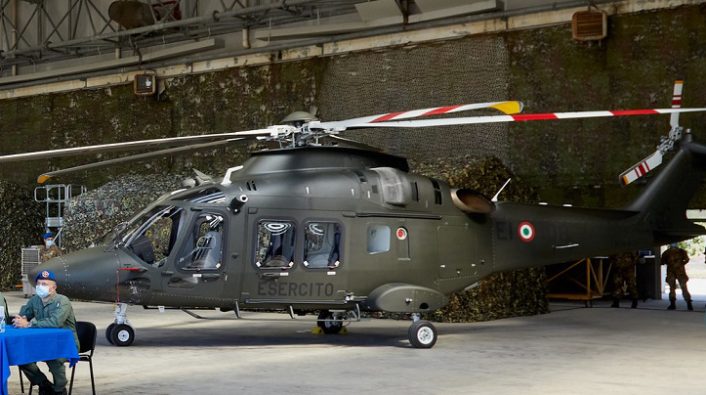
In Italy the Italian Air Force started taking delivery of the new HH-139B, a new platform configuration compared to the existing fleet of HH-139As and VH-139As, and assigned to SAR, utility, firefighting and slow mover interceptor duties.
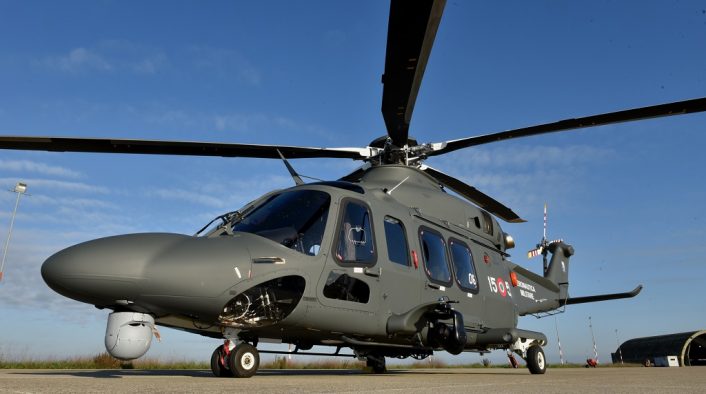
A further success in the military sector is represented by the German Navy programme for 31 NH90 NFH Seat Tiger with Leonardo playing the traditionally strong role for naval variant integration in the framework of the NHIndustries JV. Progress has been reported with the manufacturing of the Polish Navy AW101 in ASW/CSAR configuration, the operational readiness of the AW101 NAWSARH in Norway (now designated SAR Queen) and the first flights of the first NH90 NFH and TTH for Qatar, among others.
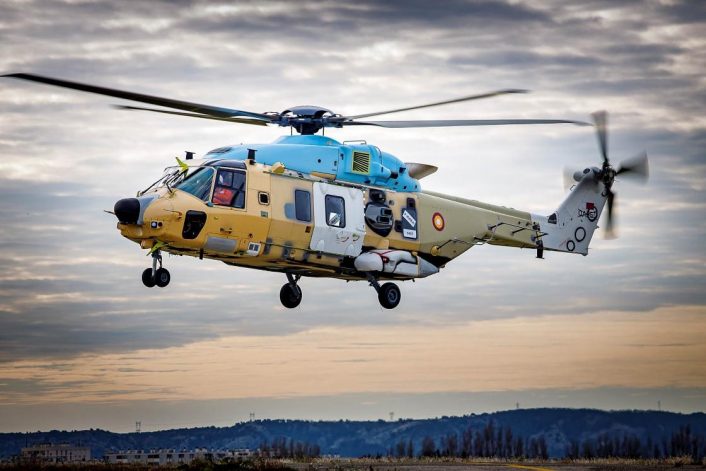
In the unmanned sector, Leonardo successfully demonstrated Manned-Unmanned Teaming capabilities integrating UAV controls into the mission system of an AW159 Wildcat in UK.
In the civil market, the product range capabilities were strengthened with the introduction of the EASA certified AW189K with Safran Aneto 1K engines, AW139’s Honeywell Primus Epic core avionics Phase 8 software release introducing more digitalized and navigation capabilities as well synthetic vision, the announcement of a performance package increase for the AW169 and skids as an alternative option to fixed and retractable landing gear, the first success in the civil market for the IFR FAA-certified AW119Kx with an order by a US EMS operator as few key examples.
While the sales prospects for commercial tilt-rotor aircraft are unclear, the AW609 program development has moved forward with the first two production aircraft on the assembly line in Philadelphia and the arrival of the first simulators which will be part of the new US Training Academy set to be opened in early 2021. Moreover, the Tokyo Metropolitan Government also launched a study to assess the potential of the AW609 for connections with remote islands leveraging the capabilities of the AW609 in terms of combined turboprop-like performance and rotorcraft flexibility in terms of takeoff and landing and hovering.
As for the fixed-wing lines, Leonardo helicopters have been used in Italy and worldwide throughout the year to face the pandemic. Interestingly, in a few weeks since the outbreak of COVID-19, Leonardo developed with certification and healthcare authorities as well as operators guidelines to sanitize interiors, personnel processes and transport of bio-hazard systems for COVID patients. The AW139 and AW169 were the world’s first civil certified EMS helicopters capable to transport a biocontainment system thanks to modern design, large and ergonomic cabin space, power to ensure ventilation. This led to set a new benchmark then offered to operators and authorities in several other nations.
ELECTRONICS
At the beginning of December Leonardo, in line with “Be Tomorrow – Leonardo 2030” Strategic Plan and “committed to serving and protecting communities around the world, contributing to their sustainable growth by leading in next generation technologies”, installed the supercomputer davinci-1 in Genoa. Davinci-1 was immediately included among the top 100 supercomputers in the world according to the TOP500 ranking, and is among the most powerful supercomputers in relation to the A&D (Aerospace & Defence) sector. The supercomputer was created through a technological partnership with Atos and boasts the latest generation NVidia A100 accelerators.
With the davinci-1, Leonardo will be able to accelerate technologies that represent the present and future of innovation: Artificial Intelligence and Autonomous Intelligent Systems, Big Data Analytics, High Performance Computing, Electrification of Aeronautical Platforms, Materials and Structures, and Quantum Technologies. According to the company, “the supercomputer represents a jewel in the Italian HPC panorama, a knowledge accelerator able to enhance the industrial digitalization process with direct repercussions for competitive development, not only for the Company but also for the Country.” For this reason, Leonardo has created the Corporate Research Program, carried out through the Leonardo Labs, including Genoa, which will be an attraction for young international researchers.

Leonardo has a recognized leadership in the field of avionics radars and ISTAR solutions.
In particular, in the fire radar control segment, in September 2020, BAE Systems and Leonardo have been awarded a 317M GBD contract to develop the Active Electronically Scanned Array (AESA) European Common Radar System Mark 2 (ECRS Mk2), the next generation of radar for the Royal Air Force Eurofighters. The ECRS Mk2 is a multi-functional array (MFA) that will give UK Typhoons a world-leading Electronic Warfare capability, in addition to traditional radar functions, including wide band Electronic Attack. This game-changing capability will replace the mechanically-scanning radar that RAF Typhoons are currently equipped. It also enables Typhoon to link up with future data-driven weapons to combat rapidly evolving air defences.
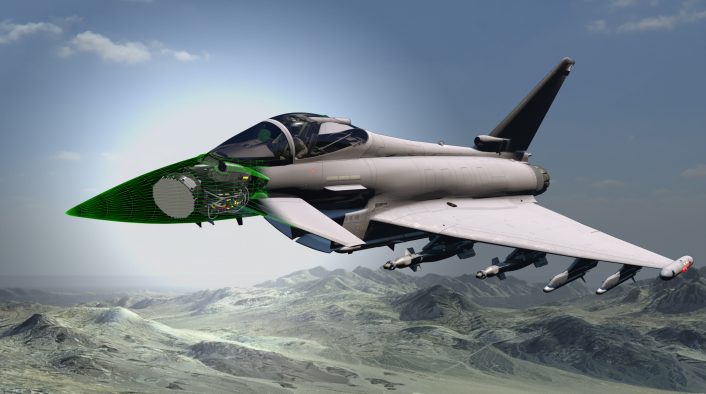
The radar has significantly more Transmit-Receive Elements than other radars, making Mk 2, what Leonardo claims to be the most capable fighter AESA radar in the world, maintaining the same power and precision of traditional radars but also enabling the simultaneous operation of its wide-band Electronic Warfare functionality. BAE Systems, the UK’s prime contractor for the Typhoon, will integrate the new sensor which will be developed by Leonardo, which for Eurofighter program, develops also large part of the fighter airframe and over 60% of avionic systems. The sensor technologies developed for Typhoon will bring to advanced avionics architecture for the next generation combat system Tempest.
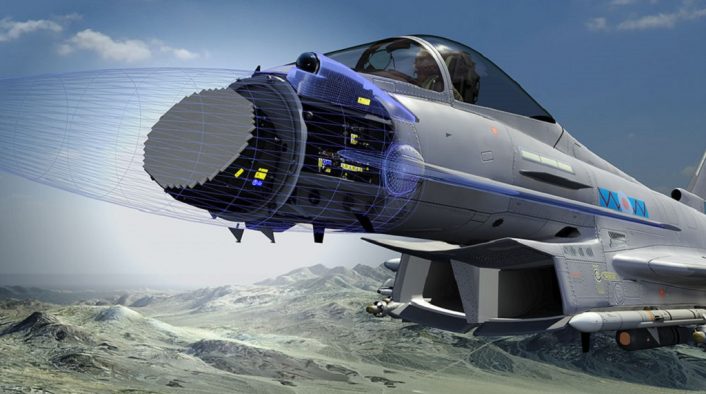
2020 was an important year for the developments made in the field of Unmanned Aerial Systems (UAS), where Leonardo is among the world’s most active players with several internal projects as well as participations in multinational programs, like RPAS or nEUROn.
On Jan. 17, 2020, Leonardo announced the maiden flight of its new Falco Xplorer drone aircraft. The Remotely-Piloted Air System (RPAS) has been designed to offer persistent, multi-sensor strategic surveillance to military and civil customers. In September, Leonardo has also delivered the first of four complete baseline counter-drone systems to the Royal Air Force in support of the next stage of its Counter-Unmanned Aerial System (C-UAS) research and development programme. The ORCUS system is now playing a key role in a wide-ranging testing and evaluation campaign which will improve the Air Force’s understanding of how it can employ technology in response to the threat posed by hostile drones.
Other important developments in the unmanned sector saw the use of drones for medical delivery. The transportation of biological samples with drones was the goal of the test, which has been successfully completed in October, designed and undertaken by Leonardo, Telespazio (joint venture between Leonardo 67% and Thales 33%) and Bambino Gesù Children’s Hospital, in collaboration with ENAC (Italian Civil Aviation Authority). This was one of the first demonstrations in Italy of biological samples and biomedical products delivery, along routes not easily accessible by ordinary roads, with the aid of vertical take-off drones equipped with electric propulsion and therefore with a very low ecological and acoustic impact. The drone transported material flying between two sites of the Bambino Gesù Children’s Hospital for more than 32 kilometers, using an automatic control mode beyond the operator’s visual line of sight (BVLOS).
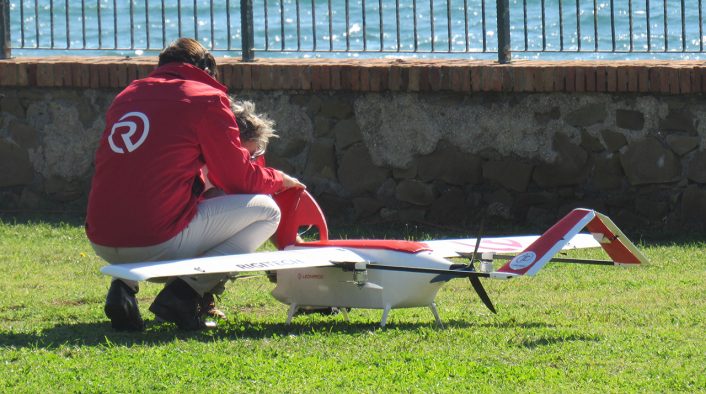
Dealing with the European MALE RPAS (Medium Altitude Long Endurance Remotely Piloted Aircraft System), a joint European programme launched by Airbus D&S, Leonardo Aircraft Division and Dassault Aviation as a joint industrial-government initiative to answer future European requirements and backed by the governments of France, Germany, Spain and Italy, 2020 saw a decisive step forward with the completion of the negotiation phase for the Stage 2 Contract.
The four Programme Participating States (PPS) confirmed at the 7th Programme Board on Nov. 19, 2020, that the necessary contract conditions, prices and performance have been met to allow the launch of the final PPS’s national staffing processes shortly. The MALE RPAS will be designed to become one of the main pillars of any future combat air system and will offer European industries the opportunity to participate in a large Unmanned Aerial Vehicle (UAV) programme designed to integrate into civil air traffic and operate in non-segregated airspace.
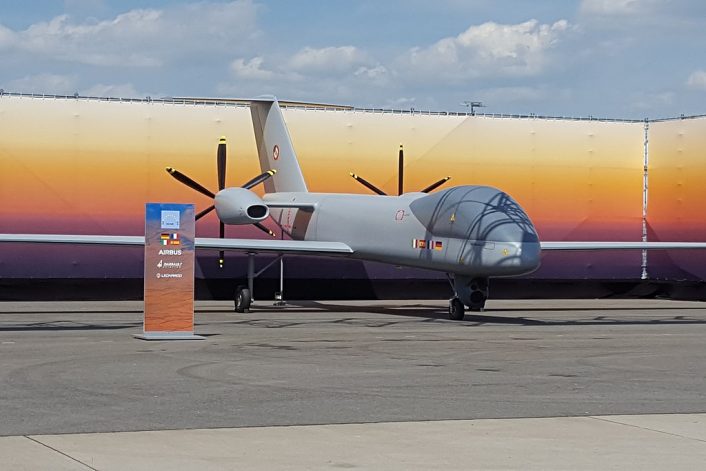
The year also saw the return to flight whit a test campaign of Skydweller, a new class of unmanned energy solar power aircraft capable of carrying large payloads whit unlimited in-flight persistence capability, developed by Skydweller Aero Inc., where Leonardo has invested.
“Open Innovation” was the key factor for the first edition of the “Leonardo Drone Contest”, a competition launched by Leonardo in collaboration with six Italian universities to promote the development of Artificial Intelligence for unmanned systems. The goal of the “Leonardo Drone Contest”, won this year by The Politecnico di Milano, is to create synergies between development and academic research in the fields of Artificial Intelligence, Computer Vision, Sensor Fusion and Machine Learning for the development of technologies for applied artificial intelligence to unmanned systems and the birth of an ecosystem that involves large companies, universities, small and medium enterprises (SMEs), spin-offs and startups.
SPACE
Leonardo, together with its joint ventures Thales Alenia Space (joint venture between Thales 67% and Leonardo 33%) and Telespazio (joint venture between Leonardo 67% and Thales 33%), is also active in the space business and over the years has contributed and still contributes to some of the most important international missions. Through its expertise in satellite manufacturing, satellite solutions and services, electro-optical and radar instruments, robotic arms and drills, and state-of the art equipment such as solar arrays and attitude sensors, Leonardo is on-board of many key missions for both earth observation and space exploration.
Furthermore, Leonardo also owns some shares of Avio (about 30%), leader in the space launcher and spacecraft propulsion sector, famous for its Vega launchers.
Despite the worldwide COVID-19 pandemic, the space sector in 2020 has achieved some major milestones for the development of future programs.
Few weeks ago, Leonardo signed the contracts with the Italian Space Agency (ASI) and the Italian Ministry of Defence for two additional COSMO-SKyMed Second Generation satellites. COSMO-SkyMed is an Earth observation satellite system of ASI and the Ministry of Defense. It is a “dual-use” constellation for both civil and defense purposes, with SAR “eyes” (Synthetic Aperture Radar) capable of monitoring the phenomena of the Earth in any weather condition. COSMO-SkyMed images are used worldwide to support populations affected by natural disasters such as earthquakes and fires, but also for the control of cultural and artistic heritage, of critical infrastructures, for monitoring the receding of glaciers, that of oil spills in the seas and for the optimization of agricultural techniques.
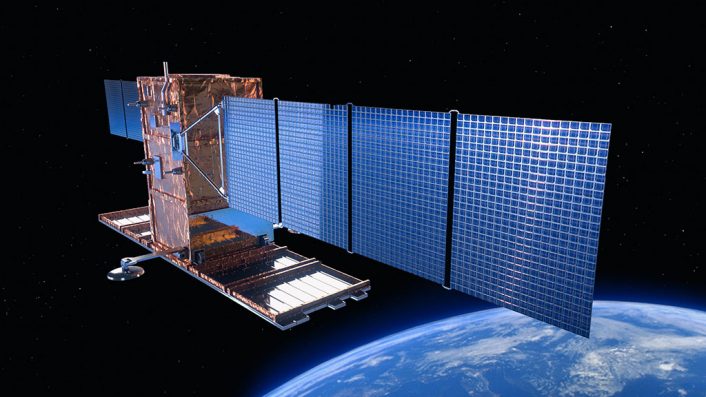
This was not the only major new contract for Earth observation programs in 2020. Indeed, Leonardo, through Thales Alenia Space, has been awarded the leadership for the construction of three new Sentinels the European program Copernicus (European Space Agency and European Commission). CHIME, CIMR and ROSE-L will join the Copernicus sentinels and strengthen the program’s goal of observing Earth and acquiring useful data for environmental protection, climate monitoring, natural disaster assessment and other social tasks.
Yet, 2020 can definitely be marked as an important year for the evolution of space exploration programs, in particular for the Artemis and Mars Sample Return programs, respectively for the return of men and the first woman on the Moon and for the exploration of Mars.
Leonardo is also widely involved in both NASA programs which have received important contributions from ESA and ASI. For the ARTEMIS program, which is also highly supported by the Italian Government, Leonardo, through Thales Alenia Space, is developing some of the key modules of the Lunar Gateway, the future lunar orbital platform. In particular, it is in charge of I-HAB, the international habitation module and ESPRIT, the communications and refueling module, as well as participating in the development of the pressurized module of HALO: the initial crew cabin for astronauts visiting the lunar Gateway.
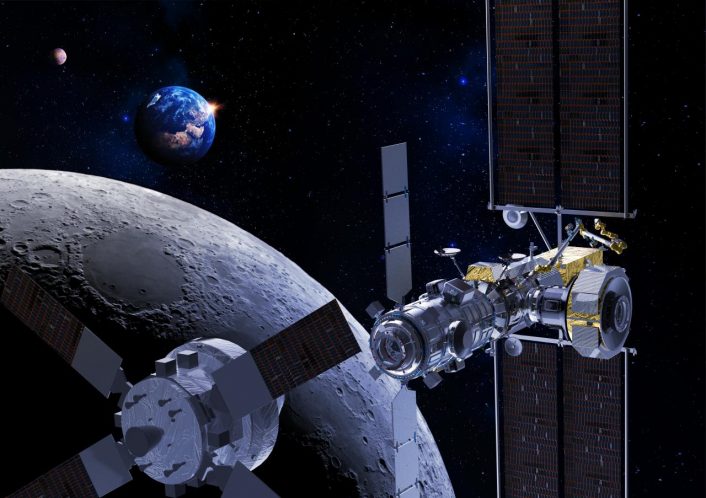
Thales Alenia Space is also involved in NASA’s Human Landing System (HLS) initiative, as part of the Dynetics-led consortium. In addition, Leonardo is also providing key equipment to the European Service Module of the Orion capsule – such as the photovoltaic panels and thermo-mechanical systems – that will comfortably and safely fly the astronauts from Earth to the Gateway.
Along with the projects of exploring the Moon, at the beginning of the year, Leonardo also signed an important contract with ESA for the development of PROSPECT, the drill and mini-lab, of the ESA-Roscosmos “Luna27” mission. PROSPECT will search and analyze the lunar resources (such as water or other volatiles) which can be useful to develop the perfect habitat for a continuous human presence on the Moon or that can be used as propellant to reach Mars. As a matter of fact, the ultimate goal of the endeavor of returning to the Moon is to find a way to reach Mars.
This summer, NASA launched Perserverance that will collect and drop sample tubes of the Martian soil. In the following years two more missions will reach the Planet to pick-up and return the tubes. ESA and ASI are supporting this very complex program and Leonardo is contributing with key elements. This year, Leonardo received the contracts to continue the study and design of two robotic arms that will collect and transfer the tubes, one for the ESA Sample Fetch Rover and the other for the NASA lander. On the other hand, Thales Alenia Space is contributing to the Earth Return Orbiter (ERO) and will supply the communication system allowing data transmission between Earth, ERO and Mars, will design the crucial Orbit Insertion Module, and manage the Assembly Integration and Test (AIT) phase for the Proto-Flight model of the ERO spacecraft.
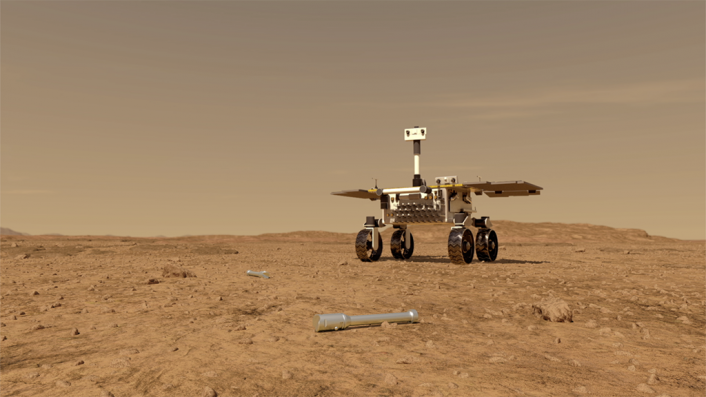
2020 marked also an important year for the announcement of the European reentry vehicle “Space rider”. Space Rider is Europe’s solution for its own affordable and reusable end-to-end integrated space transportation system for unmanned missions and for routine access and return from low orbit. It will be used to transport a variety of payloads into different low Earth orbit (LEO) altitudes and inclinations. Designed as a free-flying orbital platform, Space Rider is capable of remaining two months in orbit, safely re-entering the atmosphere and landing on the ground with a precision of 150 metres. It can be recovered along with its payload, refurbished, and reused for up to six missions. First launch is currently scheduled for 2023. Leonardo participates to this news program through Thales Alenia Space and Avio, for the development and launch of the automated reusable Space Rider transportation system, and through Telesapazio which together with Altec will manage the ground segment and operations of the mission.
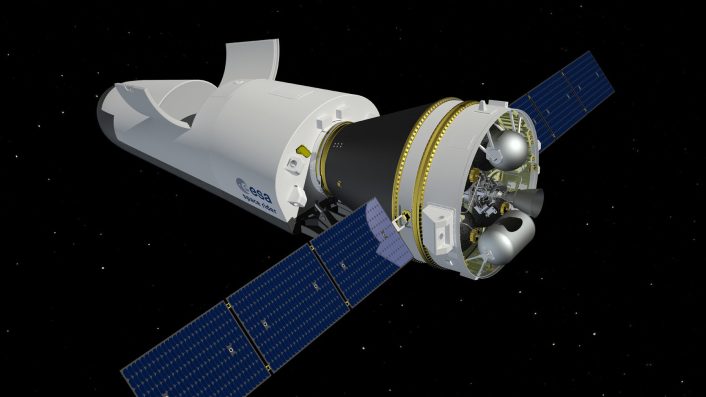
During the COVID-19 pandemic, space services and applications also came in support of institutions and the general health system. Leonardo, together with Telespazio and e-GEOS developed several innovative and digital services and platforms to help the healthcare sector managing the crisis through the analysis of space images and other integrated data. For instance, during the emergency, e-GEOS, through the ESA/European Commission Copernicus EMS Rapid Mapping service, has provided the authorities with detailed maps of cities and towns for the monitoring of the public places most subject to risks. More recently, Telespazio and e-GEOS launched “HERMES”, an ecosystem of services to help hospitals and first aid units to better respond to health emergencies.
Thanks to a high-speed telecommunications infrastructure and Big Data analysis using Artificial Intelligence, HERMES supports applications capable of providing a tool for determining the pandemic evolutionary trend over time. Moreover, thanks to its expertise and strategic concept, in the summer the Group has also won an important international tender of the United Nations Industrial Development Organisation (UNIDO) with the proposal for the development of a platform to deal with the new challenges of the health crisis.

